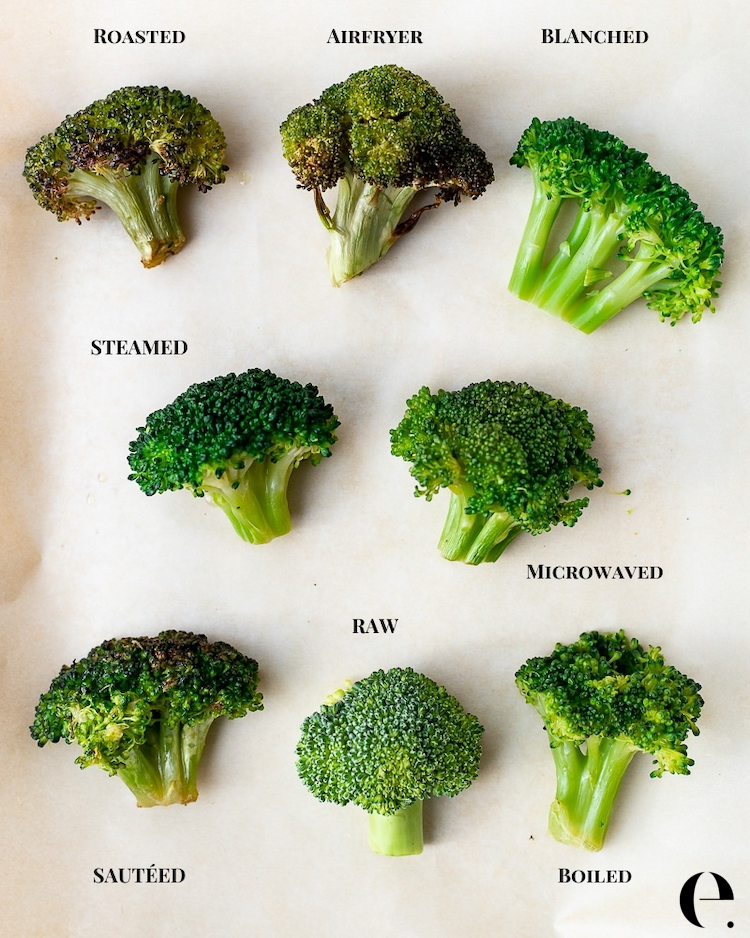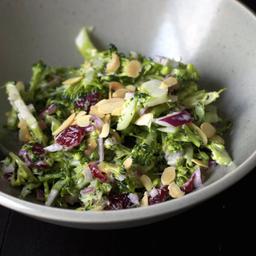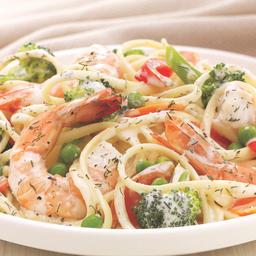
My sister once painted a pretty picture of broccoli in a field with a sunset in the background. Ha ha ha, she wasn’t amused that I thought her trees looked like broccoli…but the rest of the family had quite the laugh! But really, if you look at a stalk of broccoli and squint a little, you can see it does look like a tree with a lot of green leaves. We ate broccoli often as kids, so I knew what I was talking about. It still makes me smile when I announce to my family that we will be having “trees” for dinner tonight!
 In fact, broccoli is one of my favorite veggies. I like it prepared in any way possible. Not everyone loves this super healthy cruciferous vegetable but preparing it a different way might just convert a picky eater. Broccoli tends to have a fairly strong flavor and smell. If it’s overcooked, it can be mushy, and if you eat more than a cup at a time, you can end up with a gassy tummy. So the key is to learn how to prepare it so everyone at your table can enjoy eating it and benefiting from its healthy properties.
In fact, broccoli is one of my favorite veggies. I like it prepared in any way possible. Not everyone loves this super healthy cruciferous vegetable but preparing it a different way might just convert a picky eater. Broccoli tends to have a fairly strong flavor and smell. If it’s overcooked, it can be mushy, and if you eat more than a cup at a time, you can end up with a gassy tummy. So the key is to learn how to prepare it so everyone at your table can enjoy eating it and benefiting from its healthy properties.
I used to be afraid of broccoli, but I got over it. Now I can face it “head” on.
Fresh is Fabulous: Choose fresh, green, and firm broccoli. If the florets are yellowing or the stem ends look dry or are browning, then it is on its way to being overripe and will taste bitter.
Prep for Best Results: Clean in fresh water and pat dry. Cut the branches to equal size for consistent cooking. The stems are more dense so cut them smaller than the florets. Pre-bagged options are great, but I would still clean the florets before using them.
 1 large head of broccoli or a 12-ounce bag of fresh florets equals about 4 cups.
1 large head of broccoli or a 12-ounce bag of fresh florets equals about 4 cups.
Simple Storing: You can store uncooked fresh broccoli for up to one week in your refrigerator’s crisper drawer. (I’ve stored it for longer!) Check to see if the florets are becoming yellow or the stalks seem “bendy”. Cooked broccoli will also last a day or two if stored covered in the refrigerator, although it might lose its crispness. I often toss leftover cooked broccoli into my scrambled eggs in the morning. It’s also great to add to spaghetti sauce or soup for some extra hidden nutrition.
Frozen is Fantastic: Broccoli is in season from April to October, but you can get tasty broccoli all year. Frozen broccoli is just as nutritious as fresh. Frozen broccoli cooks faster than fresh, so be careful not to overdo it. I often use frozen when I’m making a blended soup or a casserole.
 Waste Not: Keep discarded stems in the freezer to add to soups or to make stock. I even toss the leaves into veggie stock. If you have extra fresh broccoli that may not get used, then give it a quick blanch, allow it to dry, and freeze for up to 3 months. Homemade frozen cooked broccoli is usually a little soft so I use it for soups and sauces.
Waste Not: Keep discarded stems in the freezer to add to soups or to make stock. I even toss the leaves into veggie stock. If you have extra fresh broccoli that may not get used, then give it a quick blanch, allow it to dry, and freeze for up to 3 months. Homemade frozen cooked broccoli is usually a little soft so I use it for soups and sauces.
Broccoli might be dull to some, but it’s certainly a “head” above the rest.
Cooking Tips:
- Steamin’ Good: Just 3 minutes in a steamer basket over boiling water will give you perfectly tender but not mushy results. It should be bright green, and even if you think it might be under-done, don’t keep it on the burner. The steam will continue to cook until you serve. We love steamed broccoli just as it is, but if I want to mix it up I’ll sprinkle on some Parmesan for extra pizazz.
- Sizzlin’ Sauté: Add a tablespoon of oil to your pan over medium to high heat. Add in the broccoli, stirring frequently for about 5 minutes until it’s tender. Once you have tried this method of cooking, you will be hooked. DinnerTime has loads of tasty sautéing recipes that make it fast and easy to get a delightful meal on the table.
 Blanching Beauties: Blanching is a method of quick cooking. Carefully add your broccoli to boiling water and cook for 1 minute. Any more time, your broccoli will become too soft and lose much of its nutritive value. Quickly move the broccoli to a bowl of ice water to stop it from cooking further. It should be bright green and a little crunchy. When my children were toddlers, I would give them a stalk of blanched broccoli to eat. It was firm enough for them to hold but soft enough for them to eat easily…even before they had a lot of teeth!
Blanching Beauties: Blanching is a method of quick cooking. Carefully add your broccoli to boiling water and cook for 1 minute. Any more time, your broccoli will become too soft and lose much of its nutritive value. Quickly move the broccoli to a bowl of ice water to stop it from cooking further. It should be bright green and a little crunchy. When my children were toddlers, I would give them a stalk of blanched broccoli to eat. It was firm enough for them to hold but soft enough for them to eat easily…even before they had a lot of teeth!- No Mess Microwave: Microwaves sometimes get a bad rap but an article by Harvard Health Publishing noted that no nutrients are lost by microwaving vegetables. Place broccoli in a microwave-safe bowl with a 1/4 cup of water. Cover and microwave on high for 3-4 minutes. Some folks think microwaved broccoli has less flavor, so if you have someone in your household who is a picky eater, try this method to introduce broccoli with a more subtle flavor.
- Remarkable Roasting: Toss with olive oil and preferred herbs and seasonings such as garlic powder, Italian seasoning blends, etc. Roast on a sheet pan at 400° for 20–25 minutes until you can start to see the caramelized edges, but it’s still slightly crunchy. Some folks like to roast a little longer, and some a little less. Experiment to find your favorite. Note: if you are roasting other ingredients, you may want to add them to the sheet pan at different times based on how long they need to cook. Roasted broccoli is yummy fresh from the oven or cooled and added to salads.
- Amazing Air-Fryer: Broccoli cooked in an air-fryer will produce a similar taste and texture as when it has been roasted. The good news is that air-frying takes about half the time…and the broccoli is even crispier. Yum. Toss the broccoli with olive oil and your favorite seasonings and place in the air fryer’s basket. Cook at 375° until the broccoli edges start to caramelize, about 10-12 minutes. Shake the basket after about 5 minutes to ensure even cooking.
- Refreshingly Raw: Cut in pieces easy for dipping. I always include small florets on a crudités platter. Kids love that the florets look like trees and will gobble them up. Or, make a picture on a plate using broccoli as trees, a slice of orange as the sun… little pretzel sticks to make a person….it’s fun to play with our food!
Why did the broccoli take a selfie? So it could “stalk” itself later.
Beloved Broccoli Recipes
Search for more delightful recipes in your DinnerTime Recipe Box.
Use the filter function (found on right of your DinnerTime Recipe Box search) to find desserts, main dish, side dishes etc.



